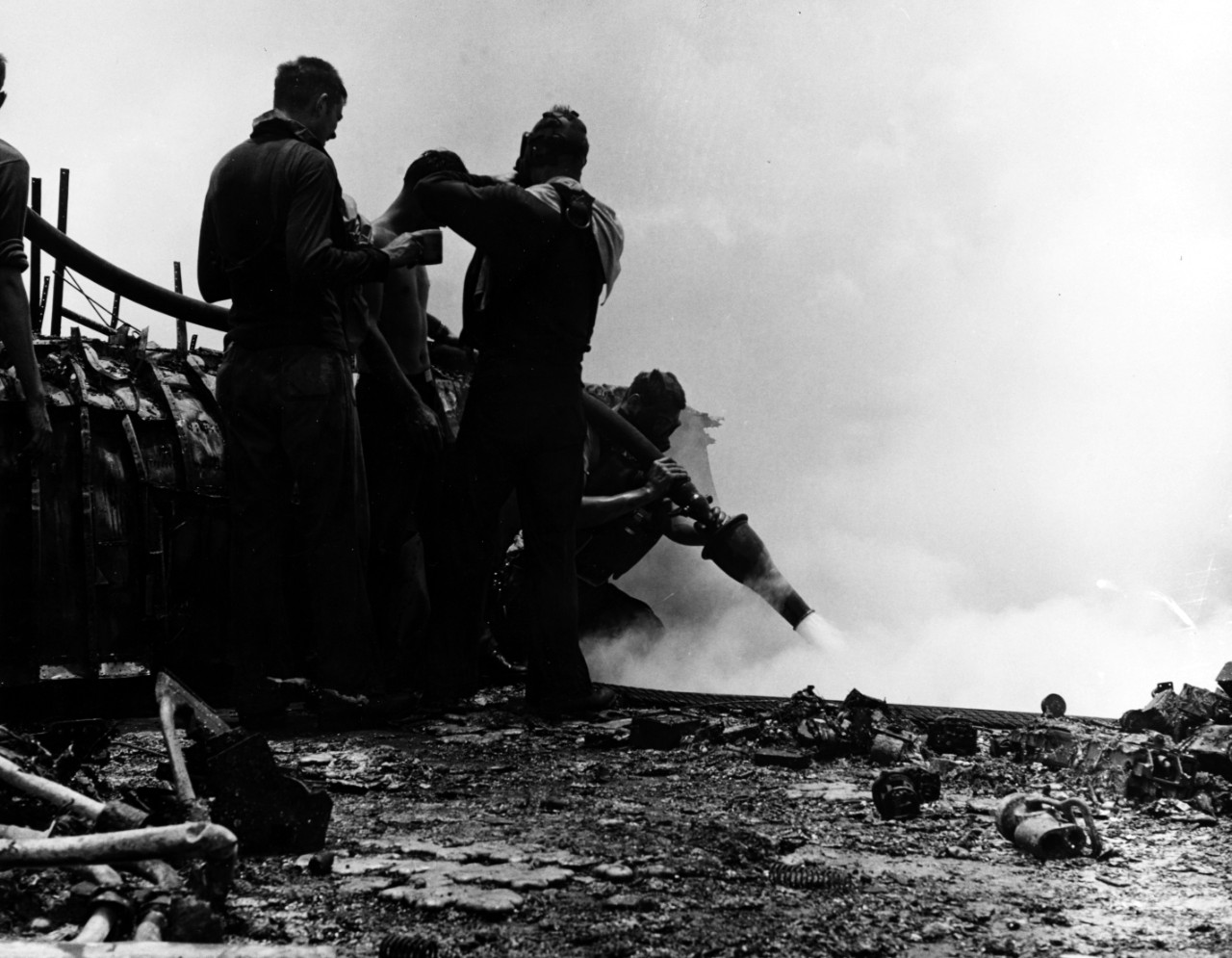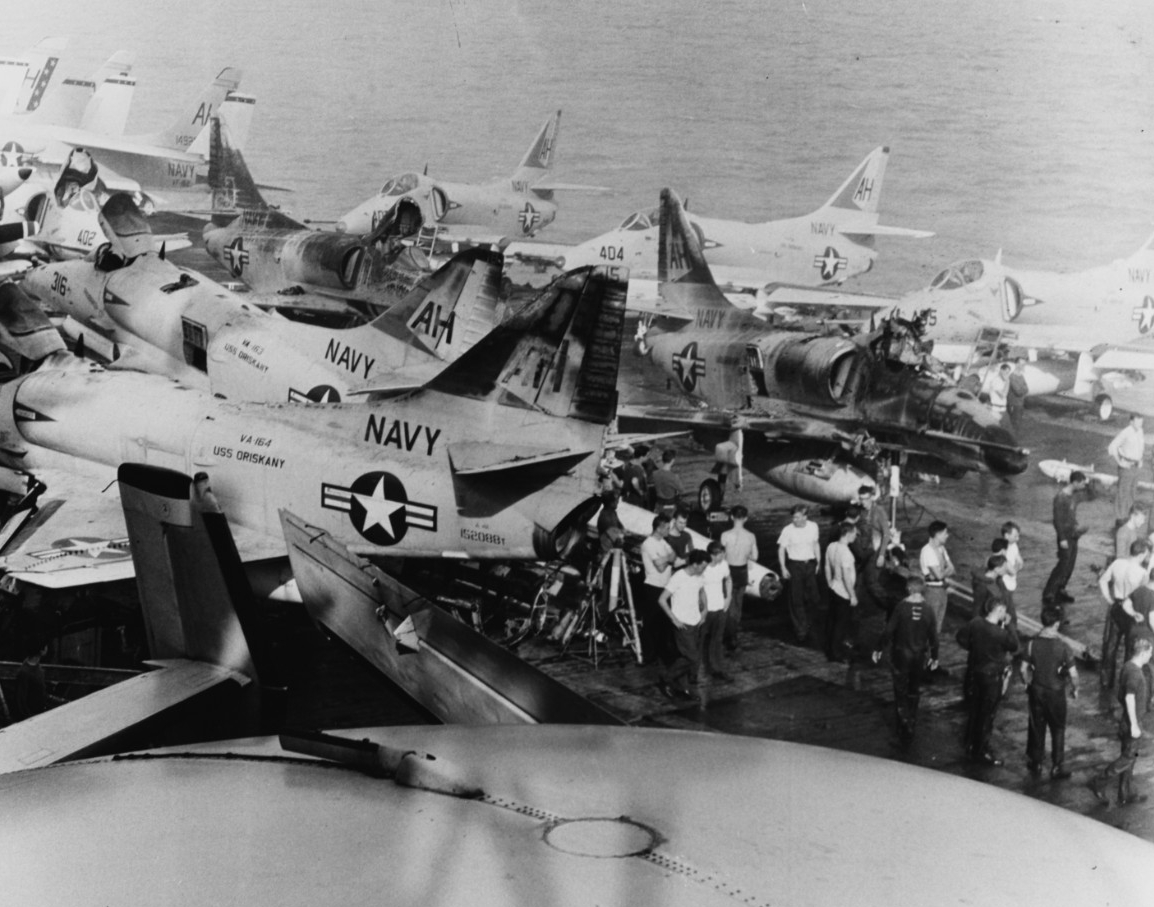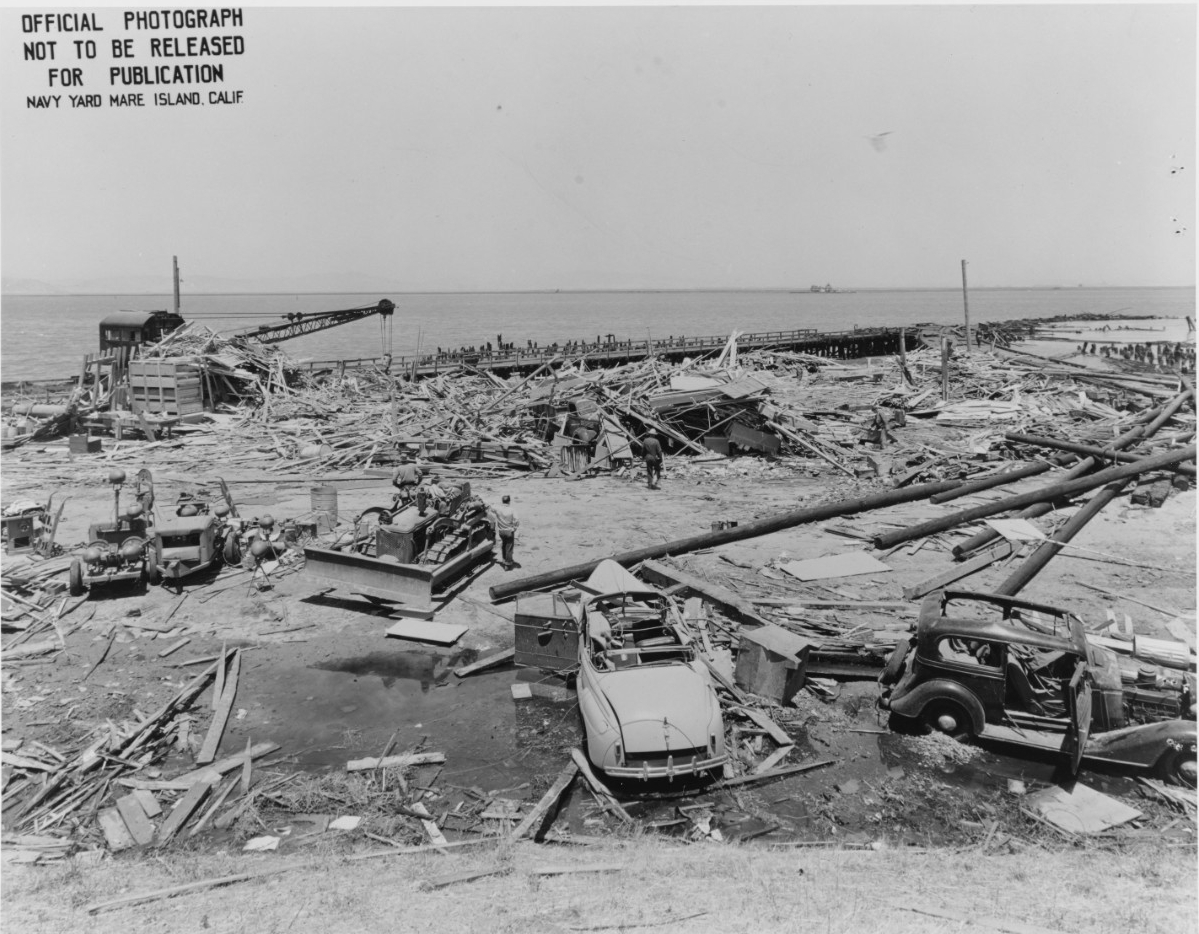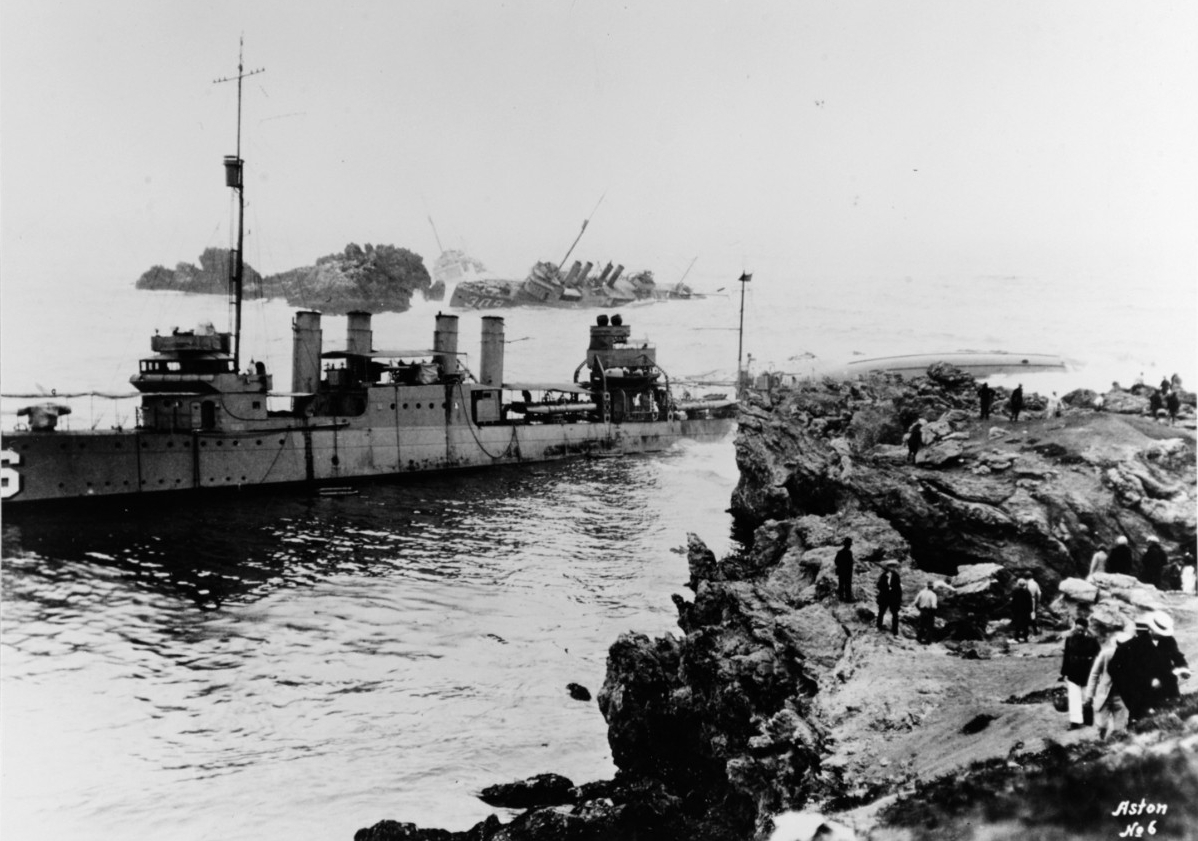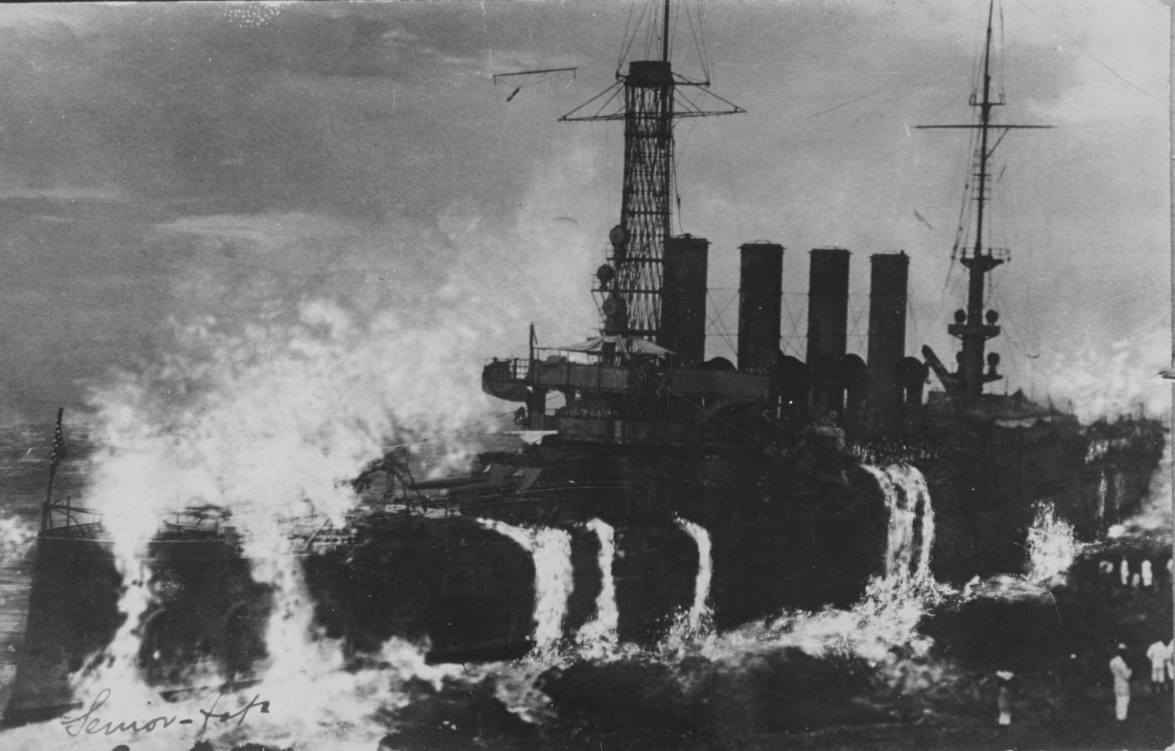H-075-2: A Short History of U.S. Navy Accidents and Non-Combat Losses
Aboard Forrestal (CVA-59), crewmen battle compartment fires from the after flight deck in an attempt to check the series of fires and explosions raging through the after sections of the ship. These were due to an initial blast that occurred when heavily armed and fueled aircraft were being prepared for launch during operations in the Gulf of Tonkin, 29 July 1967 (USN 1126632).
By historic standards, the safety record of the U.S. Navy since 1990 has been extraordinarily good. The collisions of Fitzgerald (DDG-62) and John S. McCain (DDG-56) broke an unprecedented streak of no major fatal accidents since a steam valve rupture on Iwo Jima (LPH-2) in 1990 that killed 10. Prior to about 1990, accidents of that magnitude occurred almost on a yearly (or more frequent) basis dating back to the founding of the Navy. Some of the factors cited in the recent collisions, such as undermanned, overtasked ships with deferred maintenance and fatigued crews, have actually been the norm, also dating back to the founding of the Navy. (Commander-in-Chief, U.S. Fleet, Admiral James O. Richardson’s description of the Fleet in 1939 is virtually the same as it is today, for example.)
Even in non-combat situations, U.S. Navy operations have always been inherently very dangerous, with losses of ships and especially crews very commonplace, usually due to the elements. However, disease and ordnance and machinery accidents accounted for many casualties. NHHC tracks over 3,000 U.S. Navy shipwrecks (one-third sunk as targets) and over 14,000 aircraft wrecks—a majority of these comprise non-combat losses.
In 1781, the Continental Navy sloop Saratoga was lost in a gale with all hands (about 80). It was the first of at least 27 U.S. Navy ships lost with all hands (many of those ships lost without a trace) due to non-combat causes, the last being Scorpion (SSN-589) in 1968. The last surface ship lost without trace was the tug Conestoga (AT-54), with 56 crewmen, in 1921 (her wreck was identified in 2015). The frigate Constitution recorded her first fatalities at the start of her second voyage in 1799 (falls from the tops or overboard).
Throughout the 1800s, losses were frequent, some with high casualties, such as frigate Insurgent, which vanished in September 1800 with 340 crewmen, or screw sloop-of-war Oneida, sunk in a collision off Yokosuka, Japan, in 1870 with a loss of 125 crewmen. There were other major ship losses with fortunately few or no casualties, such as steam frigate Missouri, the newest, largest, and most technologically advanced ship in the Navy at the time, which burned and sank at Gibraltar in 1843. Another notorious accident was the explosion of the “Peacemaker” gun on screw sloop-of-war Princeton in 1844 that killed the Secretary of State, Secretary of the Navy, and only by luck missed President John Tyler.
The Navy did not begin systematically keeping records of non-combat deaths until about 1900. Between then and World War I, non-combat deaths in the Navy varied between 250 and 350 per year. Early in the century, diseases such as tuberculosis and pneumonia, as well as food poisoning and drowning, accounted for many. However, as those types of deaths began to decline in the 1920s, they were balanced by increased fatalities in submarines, aviation, and vehicle accidents. Throughout that period, shipboard deaths due to steam ruptures, boiler explosions, coal dust explosions, oil fires, ammunition accidents, malfunctioning machinery, electrocution, and similar accidents accounted for 100 or more deaths per year.
The advent of armored turrets proved to be an increased hazard to gun crews in peacetime (albeit a godsend in wartime), and major internal turret explosions occurred with distressing regularity: Massachusetts (Battleship No. 2), 1903; Missouri (Battleship No. 11), 1904; Trenton (CL-11), 1924; Mississippi (BB-23), 1924 and 1943; Saint Paul (CA-73), 1952; Newport News (CA-148), 1972; and Iowa (BB-61) 1989. The explosions usually killed all or most of the gun crew.
Submarine duty was particularly hazardous. The first U.S. submarine, Alligator, was lost in a storm off Cape Hatteras in 1863. Since that time, at least 23 U.S. submarines have been lost to accidents, frequently with all or most of the crew, beginning with F-4 in 1915 (all 21 crewmen lost). Of 52 submarines lost during World War II, at least six were lost due to non-combat accidents (not counting circular-running torpedoes or “friendly” fire) and another eight are simply unaccounted for, usually listed as “presumed mine strike,” but accidents cannot be ruled out.
Deaths due to accident significantly increase during wartime. In World War I, the Navy lost 431 men due to enemy action and over 4,400 due to accidents and disease (plus another 5,027 to Spanish Influenza). In World War II, the Navy lost 36,950 men killed in action and 19,781 killed in accidents and non-combat causes (another 5,500 died from “natural causes”). Within these wartime numbers were 3,173 killed in aerial combat and 8,184 killed in aviation accidents, which gives an indication of the inherent added dangers of naval aviation. Even in Vietnam, of 2,556 Navy names on the Vietnam Veterans Memorial, only 1,631 were killed in combat—the rest were due to “operational” causes.
Six U.S. Navy surface ships have been sunk by accident since World War II: Solar (DE-221), 1946; Chehalis (AOG-48), 1948; Benevolence (AH-13), 1950; LST-561, 1952; Hobson (DMS-26), 1952; and Frank E. Evans (DD-754), 1969. Four Navy submarines in commissioned status have been sunk by accident since World War II: Cochino (SS-486), 1949; Stickleback (SS-415), 1959; Thresher (SSN-593), 1963; and Scorpion (SSN-589), 1968. Guitarro (SSN-665) sank at the pier while under construction in 1969, but was raised and repaired. Two decommissioned submarines sank under tow.
U.S. Navy Accidents Resulting in Deaths of Seven or More Military Personnel, 1900–2022
Note: Use of seven deaths as threshold is purely arbitrary in order to show fatal accidents equivalent or worse than USS Fitzgerald in 2017. Lowering the threshold to three does not change the list between 1990 and the present, but it does result in a very extensive increase in the list of accidents prior to 1990. Most fatal accidents since 1990 have been aircraft with one or two deaths, or single man-overboards.
Reverse Chronology
2017, 21 August: 10 killed, destroyer John S. McCain’s collision with merchant tanker, near Singapore
2017, 17 June: 7 killed, destroyer Fitzgerald’s collision with merchant ACX Crystal, off Japan
2002, 8 May: 7 killed, collision of two T-39 trainers, Pensacola, Florida
1999, 9 December: 7 killed, amphibious assault ship Bonhomme Richard CH-46 helicopter crash, off Point Loma, California
1991, 21 March: 27 killed, mid-air collision of two P-3 Orions, off San Diego
1990, 21 December: 21 killed, carrier Saratoga, ferry capsized, Haifa, Israel
1990, 31 October: 10 killed, amphibious assault ship Iwo Jima, steam valve rupture, Arabian Sea
1989, 19 April: 47 killed, battleship Iowa, turret explosion, off Puerto Rico
1983, 17 June: 14 killed, P-3 crash, Kauai, Hawaii
1983, 1 May: 15 killed, C-131 crash, St. Johns River, Jacksonville, Florida
1982, 3 April: 11 killed, carrier Dwight D. Eisenhower, C-1A COD crash, Crete
1981, 26 May: 14 killed, carrier Nimitz, EA-6B crash on flight deck, off Florida
1981, 26 February: 16 killed, Navy C-130 crash, South China Sea
1980, 19 April: 7 killed, P-3 crash, Samoa
1977, 17 January: 49 killed, Trenton and Guam, LCM-6 collides with merchant ship, Barcelona, Spain
1975, 22 November: 8 killed, 47 injured, carrier John F. Kennedy’s collision with cruiser Belknap, off Sicily, Italy
1973, 11 December: 6 killed, 38 injured, carrier Kitty Hawk, machinery room fire, South China Sea
1973, 5 February: 7 killed, 5 injured, destroyer Basilone, boiler explosion, off Virginia Capes
1972, 1 October: 20 killed, 38 injured, heavy cruiser Newport News, turret explosion, Vietnam
1969, 2 June: 74 killed, destroyer Frank E. Evans (sunk—stern half remained afloat) collision with carrier HMAS Melbourne, South China Sea
1969, 15 January: 28 killed, 343 injured, carrier Enterprise, flight deck fire, off Oahu, Hawaii
1968, 22 May: 99 killed (all hands), nuclear attack submarine Scorpion sunk, near Azores
1967, 29 July: 134 killed, 161 injured, carrier Forrestal, flight deck fire, South China Sea
1966, 26 October: 44 killed, 156 injured, carrier Oriskany, fire, South China Sea
1964, 26 November: 12 killed, P-2V crash, Alaska
1964, 17 November: 10 killed, P-3 crash, Argentia, Newfoundland, Canada
1963, 10 April: 129 killed (all hands), nuclear attack submarine Thresher sunk, off Cape Cod, Massachusetts
1961, 23 January: 7 killed, carrier Saratoga, fuel oil fire, Aegean Sea
1960, 19 December: 46 killed, 150 injured, carrier Constellation, shipyard fire, Brooklyn
1960, 10 July: 11 killed, 20 injured, destroyers Ammen and Collett collision, Newport Beach, California
1960, 25 February: 38 killed, VR-1 R6D midair collision, Rio de Janeiro, Brazil
1954–60: Although devoid of major accidents, this period of transition to jet aircraft was characterized by a very high operational loss rate of planes and pilots to flight-deck crashes and other mishaps—the era of spectacular ramp strikes.
1954, 26 May: 103 killed, 301 injured, carrier Bennington, catapult explosion/fire, off Rhode Island
1954, 21 January: 24 killed, landing craft collision, Inchon, South Korea
1953, 15 October: 37 killed, 40 injured, carrier Leyte, catapult hydraulic fire, Boston
1953, 28 April: 11 killed, carrier Bennington, explosion, off Cuba
1952, 24 September: 176 killed, carrier Wasp and destroyer Hobson (sunk), collision, Atlantic
1952, 8 August: 14 killed, PBM Mariner crash, Shikoku, Japan
1952, 7 August: 13 killed, PBM Mariner crash, Philippines
1952, 6 August: 9 killed, carrier Boxer, hangar deck fire, Korea
1952, 21 April: 30 killed, heavy cruiser Saint Paul, turret explosion, Korea
1952, 2 March: 12 killed, LST-561 foundered, Korea
1951, 16 September: 7 killed, carrier Essex, flight deck crash and fire, Korea
1951, 14 May: 36 killed, seaplane tender Valcour, collision and fire, Virginia Capes
1951, 24 May: 19 killed, liberty launch capsized, Newport, Rhode lsland
1950, 25 August: 18 killed, hospital ship Benevolence rammed and sunk, San Francisco
1949, 25 August: 7 killed, submarine Tusk, washed overboard during rescue of crew of sinking submarine Cochino, off Norway
1948, 2 June: 31 killed, liberty launch capsized, Norfolk, Virginia
1948, 16 February: 8 killed, liberty launch capsized, southern France
1946, 30 April: 7 killed, destroyer escort Solar, ammunition explosion, Earle, New Jersey
1945, 5 December: 27 killed, flight of 5 TBM Avengers disappeared, PBM Mariner SAR flight exploded, off southeastern Florida
1945, 11 October: 73 killed, 49 injured, various ships, typhoon, Buckner Bay, Okinawa
1945, 29 January: 255 killed, ammunition ship Serpens, ammunition explosion, Guadalcanal, Solomon Islands
1944, 18 December: 790 killed, 80 injured, destroyers Monaghan, Spence, Hull sunk in typhoon, Pacific
1944, 10 November: 372 killed, 371 injured, ammunition ship Mount Hood, ammunition explosion, Manus Island, Papua New Guinea
1944, 13 September: 248 killed, destroyer Warrington, lost in hurricane off Florida
Naval Magazine, Port Chicago, California: Damage resulting from the 17 July 1944 ammunition explosion. This view looks north, showing the wreckage of Building A-7 (Joiner Shop) in the center and the destroyed ship pier beyond. Note bulldozer and damaged automobiles in the foreground, railway crane at left, and scattered pilings (NH 96823).
1944, 17 July: 320 killed, ammunition explosion, U.S. Naval Magazine, Port Chicago, California
1944, 4 July: 42 killed, submarine S-28, sunk due to unknown cause, off Oahu, Hawaii
1944, 21 May: 163 killed, 396 injured, six LSTs destroyed in ammunition explosion, Pearl Harbor, Hawaii
1944, 3 January: 138 killed, 60 injured, destroyer Turner, ammunition explosion, New York harbor
1943, 20 November: 43 killed, 19 injured, battleship Mississippi, turret explosion, Gilbert Islands
1943, 12 June: 42 killed, submarine R-12 sunk by accident, off Key West, Florida
1942, 18 February: 204 killed, destroyer Truxton and cargo ship Pollux run aground in storm, Newfoundland
1942, 24 January: 46 killed, submarine S-26 accidentally rammed, Gulf of Panama
1941, 19 June: 33 killed, submarine O-9 sunk during deep submergence test, off Portsmouth, New Hampshire
1941, 2 January: 11 killed, PBY Catalina crash, San Diego
1939, 12 May: 26 killed, submarine Squalus sank during test dive, off Portsmouth, New Hampshire
1938, 2 February: 11 killed, two PBY Catalinas collided, off California coast
1938, 5 January: 7 killed, PBY Catalina crash, off Point Loma, California
1933, 4 April: 73 killed, 3 injured, airship Akron crash, off Barnegat, New Jersey
1928, 17 December: 39 killed, submarine S-4 rammed and sunk, off Cape Cod, Massachusetts
1926, 10 July: 19 killed, 39 injured, ammunition explosion by lightning, Naval Ammunition Depot, Jersey City, New Jersey
1925, 25 September: 33 killed, submarine S-51 sank after collision, Block Island, Rhode Island
1925, 3 September: 14 killed, 2 injured, airship Shenandoah crash, Ohio
1924, 20 October: 14 killed, light cruiser Trenton, turret explosion, Virginia Capes
1924, 12 June: 48 killed, battleship Mississippi, turret explosion, off San Pedro, California
Wrecked destroyers on Honda Point, California, soon after the night of 8 September 1923, when they went ashore in a fog. In the foreground is Chauncey (DD-296) with Young (DD-312) capsized astern. Woodbury (DD-309) is in the center distance, with Fuller (DD-297) faintly visible behind her (NH 84822).
1923, 8 September: 23 killed, 15 injured, 7 destroyers ran aground and wrecked, Point Honda, California
1921, 25 March: 56 killed, tug Conestoga disappeared after departing San Francisco
1920, 11 June: 9 killed, patrol vessel PE-8 sunk in squall, Delaware Bay
1919, 19 July: 8 killed, minesweeper Richard Bulkeley, accidentally sunk by swept mine, North Sea
1918, 9 December: 10 killed, armored cruiser Brooklyn, coal dust explosion
1918, 9 October: 12 killed, destroyer Shaw collides with HMS Aquitania, Atlantic
1918, 4 October: 25 killed, collier Herman Frasch sank after collision with tanker, off Nova Scotia, Canada
1918, 27 August: 18 killed, sub chaser SC-209 mistaken for submarine and sunk, Atlantic
1918, 17 April: 17 killed, freighter Florence K, ammunition explosion killed naval armed guards, Atlantic
1918, 4 March: 306 killed (all hands and passengers), collier Cyclops disappeared, off St. Kitts, Caribbean
1918, 26 February: 40 killed, tug Cherokee foundered in gale, off Fenwick Island, Delaware
1917, 17 December: 19 killed, submarine F-1, sunk in collision, San Diego
1917, 21 December: 21 killed, destroyer Chauncy, sunk in collision, Atlantic west of Gibraltar
1916, 29 August: 41 killed, 204 injured, armored cruiser Memphis, wrecked by freak waves, Santo Domingo, Dominican Republic
1915, 25 March: 21 killed, submarine F-4 sank, battery failure, off Honolulu, Hawaii
1915, 21 January: 9 killed, armored cruiser San Diego, boiler explosion, San Diego
1910, 27 March: 8 killed, armored cruiser Charleston, gun explosion, Cavite, Philippines
1905, 21 July: 65 killed, 40 injured, gunboat Bennington, boiler explosion, San Diego
1904, 13 April: 34 killed, battleship Missouri, turret explosion, Caribbean
1903, 16 January: 9 killed, battleship Massachusetts, powder explosion, Atlantic
For the most thorough accounting of U.S. Navy non-combat casualties, see the NHHC document "Casualties: US Navy and Marine Corps Personnel Killed and Injured in Selected Accidents and Other Incidents Not Directly the Result of Enemy Action."
For an accounting of Navy ships lost to weather, see NHHC document "U.S. Navy Ships Lost in Selected Storm/Weather Related Incidents."
For an accounting of U.S. Navy surface ship accidents since World War II, see H-Gram 071 for an overview and H-071-2 for a complete list.
For a list of U.S. Navy non-combat submarine losses, see H-Gram 019 for an overview and H-019-3 for a complete list.
For an accounting of U.S. Navy ordnance accidents, see H-Gram 029's H-029-5.
For an accounting of U.S. Navy ships lost with all hands (non-combat), see H-Gram 060 for an overview and H-060-2 for a complete list.

